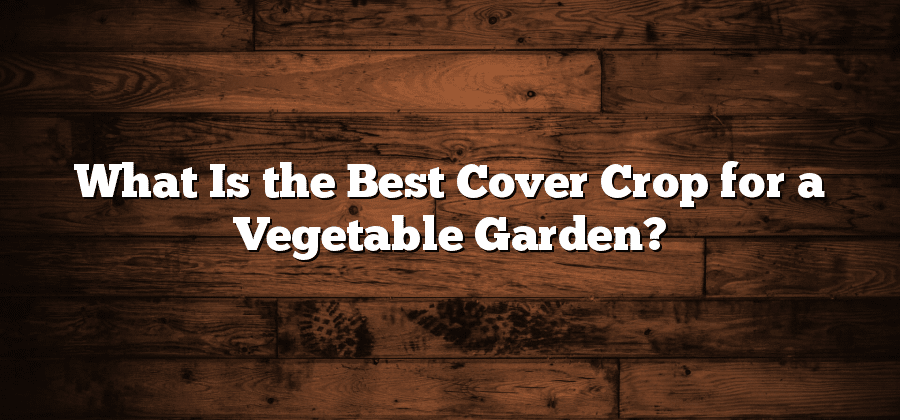Benefits of Using Cover Crops
Cover crops offer a multitude of benefits for vegetable gardeners. One of the most notable advantages is their ability to improve soil health. By adding organic matter and nutrients back into the soil, cover crops enhance its overall fertility, which can lead to increased yields and healthier plants. Additionally, cover crops help to prevent soil erosion by providing surface protection and reducing water runoff. This is especially important for vegetable gardens, as erosion can strip away valuable topsoil and hinder plant growth.
Another benefit of using cover crops is weed suppression. Cover crops provide natural competition to weeds by taking up space, sunlight, and nutrients that would otherwise be available for unwanted plants. This can greatly reduce the need for chemical herbicides and manual weeding, saving gardeners precious time and effort. Furthermore, cover crops act as a living mulch, shading the soil and preventing weed seeds from germinating. This helps to maintain a clean and tidy garden bed, free from invasive plants that can choke out vegetable crops.
Factors to Consider for Vegetable Garden Cover Crops
When selecting cover crops for your vegetable garden, it is important to consider a few key factors. First and foremost, you must evaluate the climate and growing conditions of your specific garden. Certain cover crops thrive in warmer climates, while others are more suited to cooler regions. Similarly, some cover crops require full sun, while others can tolerate partial shade. By understanding the unique requirements of your garden, you can choose cover crops that will flourish and provide maximum benefit.
Another important factor to consider is the purpose of the cover crop. Different cover crops serve different purposes, such as nitrogen fixation, soil improvement, or weed suppression. Nitrogen-fixing cover crops, for example, have the ability to convert atmospheric nitrogen into a form that can be easily used by plants. This can greatly enhance the overall fertility of your soil. Soil-improving cover crops, on the other hand, work to improve soil structure, moisture retention, and nutrient availability. Weed-suppressing cover crops, as the name suggests, help to naturally suppress weeds, reducing the need for herbicides and manual weeding. Understanding the specific goals you want to achieve with your cover crop will help guide your selection process.
Nitrogen-Fixing Cover Crops for Vegetable Gardens
Nitrogen is an essential nutrient for plant growth, and maintaining adequate levels in the soil is crucial for healthy vegetable garden productivity. One effective way to naturally add nitrogen to the soil is by incorporating nitrogen-fixing cover crops. These cover crops have a remarkable ability to convert atmospheric nitrogen into a plant-usable form, actively enriching the soil with this vital nutrient.
Legumes, such as clover, beans, and peas, are popular choices for nitrogen-fixing cover crops in vegetable gardens. These plants form a symbiotic relationship with specific bacteria in their root systems, known as rhizobia. Through this partnership, the rhizobia bacteria convert atmospheric nitrogen into a form that the legume plants can utilize. As the cover crops grow and eventually decompose, the nitrogen they have accumulated becomes available for other plants in the garden. In addition to increasing soil fertility, nitrogen-fixing cover crops also improve soil structure and water-holding capacity, making them a valuable asset for vegetable gardeners.
Soil-Improving Cover Crops for Vegetable Gardens
Cover crops play a crucial role in improving the quality of soil in vegetable gardens. These crops, when planted and later turned into the soil, add organic matter and increase the overall fertility. This, in turn, leads to healthier and more productive vegetable plants.
One of the key benefits of using soil-improving cover crops is their ability to prevent erosion. The dense root systems of these crops help bind the soil particles together, reducing the risk of erosion caused by wind or heavy rain. Additionally, the cover crops act as a protective barrier, shielding the soil from the impact of rainfall and preventing soil compaction. This allows for better water infiltration, which is essential for the growth and development of vegetable plants. By safeguarding the soil, these cover crops enable vegetable gardeners to maintain the integrity of their growing areas and optimize crop production.
Weed-Suppressing Cover Crops for Vegetable Gardens
Weed management is one of the biggest challenges faced by vegetable gardeners. Weeds compete with vegetable plants for resources such as nutrients, water, and sunlight, which can significantly reduce the overall yield and quality of the vegetables grown. One effective solution to tackle this issue is by incorporating weed-suppressing cover crops into the vegetable garden.
Cover crops that suppress weeds help to create a dense canopy that shades out weed seedlings, preventing them from germinating and establishing. This shading effect not only reduces weed competition but also conserves soil moisture, improves soil structure, and prevents erosion. Some popular weed-suppressing cover crops for vegetable gardens include annual ryegrass, buckwheat, and hairy vetch. These cover crops can be sown in between vegetable rows or as an off-season cover to smother weeds and prevent them from gaining a foothold in the garden. By choosing the right weed-suppressing cover crop and implementing proper management techniques, vegetable gardeners can significantly minimize weed pressure and improve the overall health and productivity of their gardens.
• Weed-suppressing cover crops create a dense canopy that shades out weed seedlings, preventing them from germinating and establishing.
• This shading effect reduces weed competition and conserves soil moisture.
• Cover crops also improve soil structure and prevent erosion.
• Popular weed-suppressing cover crops for vegetable gardens include annual ryegrass, buckwheat, and hairy vetch.
• These cover crops can be sown in between vegetable rows or as an off-season cover to smother weeds.
• Choosing the right weed-suppressing cover crop and implementing proper management techniques can minimize weed pressure in the garden.






